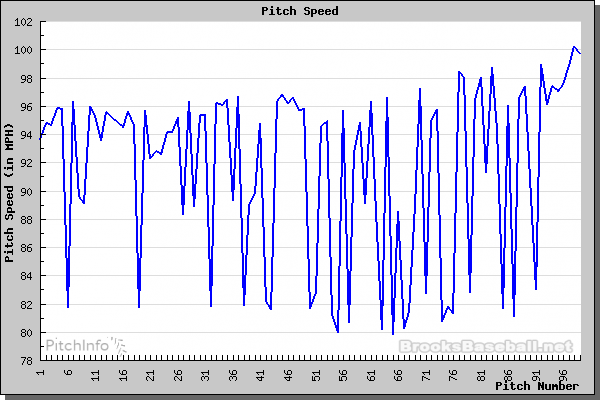Multiple Ways to Dominate: James Paxton No-Hits the Blue Jays
I was sitting down to write this, and then noticed that Jake Mailhot over at LL (and Fangraphs now?) wrote a great summary of what I was going to do here. So…uh, yeahhhh. You could just go read Jake’s article, which’ll probably be more concise.
So, as Jake has elegantly laid out, one of the striking things about last night’s game was just how *different* it was to Paxton’s last start, a start that looked more like traditional dominance. I’m not going to get into the debate over whether no-hitters are a statistical irrelevance; I think they’re cool, and I was pumped when Seager threw out Josh Donaldson last night. But Paxton’s command came and went throughout the night, he gave up a lot of loud contact, and most importantly, he approached the Jays line-up in a profoundly different way than he did the A’s on May 2nd.
You’ll remember that in that earlier start, he used high fastballs more than ever, and racked up dozens of whiffs on them. Whereas his average four-seam fastball prior to May 2nd came in below the center of the zone, they averaged 0.3 feet *above* the zone in that contest. Last night, that average dropped back to just about the center – higher than his April average, sure, but noticeably lower than against the A’s. Here’s the Baseball Savant view of his pitch mix last night – there are still plenty of high fastballs, but they’re mixed in with some low-in-the-zone heaters, too.

Was that an intentional decision? It seems likely, and there are a couple of reasons why. First, Paxton/Zunino seemed to want to work deeper into the game, and their pitch mix and locations seemed designed to elicit more contact – and they got their wish. Fewer whiffs, but more quick innings. Was this change at all related to the Jays line-up? I think so; if you look at expected wOBA or wOBA on fastballs above the midpoint of the zone, you’ll find that the Jays are one of the best hitting clubs in the game.
The problem is that in absolute (as opposed to relative) terms, they’re even better at hitting *low* fastballs. That came across last night; on fastballs below the midpoint, the Jays put 4 balls in play at an average speed of 96 mph. The 6 balls they hit on fastballs above the midpoint averaged 83 MPH off the bat.
The other difference in this game was in Paxton’s choice of secondaries/breaking pitches. His curve has been a problem all year, but last night, it was a perfect change of pace, and one Paxton used to get ground balls – including the double play that Kevin Pillar hit into. Paxton’s curve has lost some of its bat-missing power over the past few years. It got whiffs on 40% of swings over 2016-17, over a standard deviation more than the MLB average. For whatever reason, it’s getting whiffs less frequently now, but it was still able to help Paxton’s plan to pitch more economically. His cutter is and remains a swing-and-miss pitch, so it’s a testament to just how committed to their gameplan that Paxton threw so few of them last night. After throwing over 20 in 4 straight starts in April, he’s now using it sparingly, which may help its effectiveness. Or, he may just not have had a great feel for the pitch, especially after seeing Lourdes Gurriel hit a 3rd inning cutter 388 feet to the wall in left.
Essentially, Paxton and Zunino seemed to come into the game with a plan to get quick outs even if that meant going away from Paxton’s most effective pitches: the high fastball and the cutter. It worked, despite some well-struck balls in play, and it enabled Paxton to work through the 9th without breaking the 100 pitch mark. Paxton’s curve was more effective than it’s been all year, and that means Paxton has multiple ways to beat teams. That efficiency meant that late in the game, Paxton was able to reach back for more velocity when he needed it:

James Paxton is on quite a run, and there’s essentially no pitcher in the league right now teams would want to face less than Big Maple. I’m still not a huge fan of throwing low fastballs, but it’s nice to know he can give batters another look every now and again. The development of his curve is crucial to how long he can keep this level of performance up. His fastball is legitimately one of the best pitches in the game right now, right there with Kluber’s slurve. Over time, batters will learn to adjust to it, even when it’s thrown at the letters. Having a breaking ball to get quick outs or as a different putaway pitch should preserve the fastball’s effectiveness a bit longer. All hail the Big Maple.
Comments
Leave a Reply
You must be logged in to post a comment.
